ESP TOYOTA COROLLA 2022 (in English) Owner's Guide
[x] Cancel search | Manufacturer: TOYOTA, Model Year: 2022, Model line: COROLLA, Model: TOYOTA COROLLA 2022Pages: 678, PDF Size: 147.24 MB
Page 249 of 678
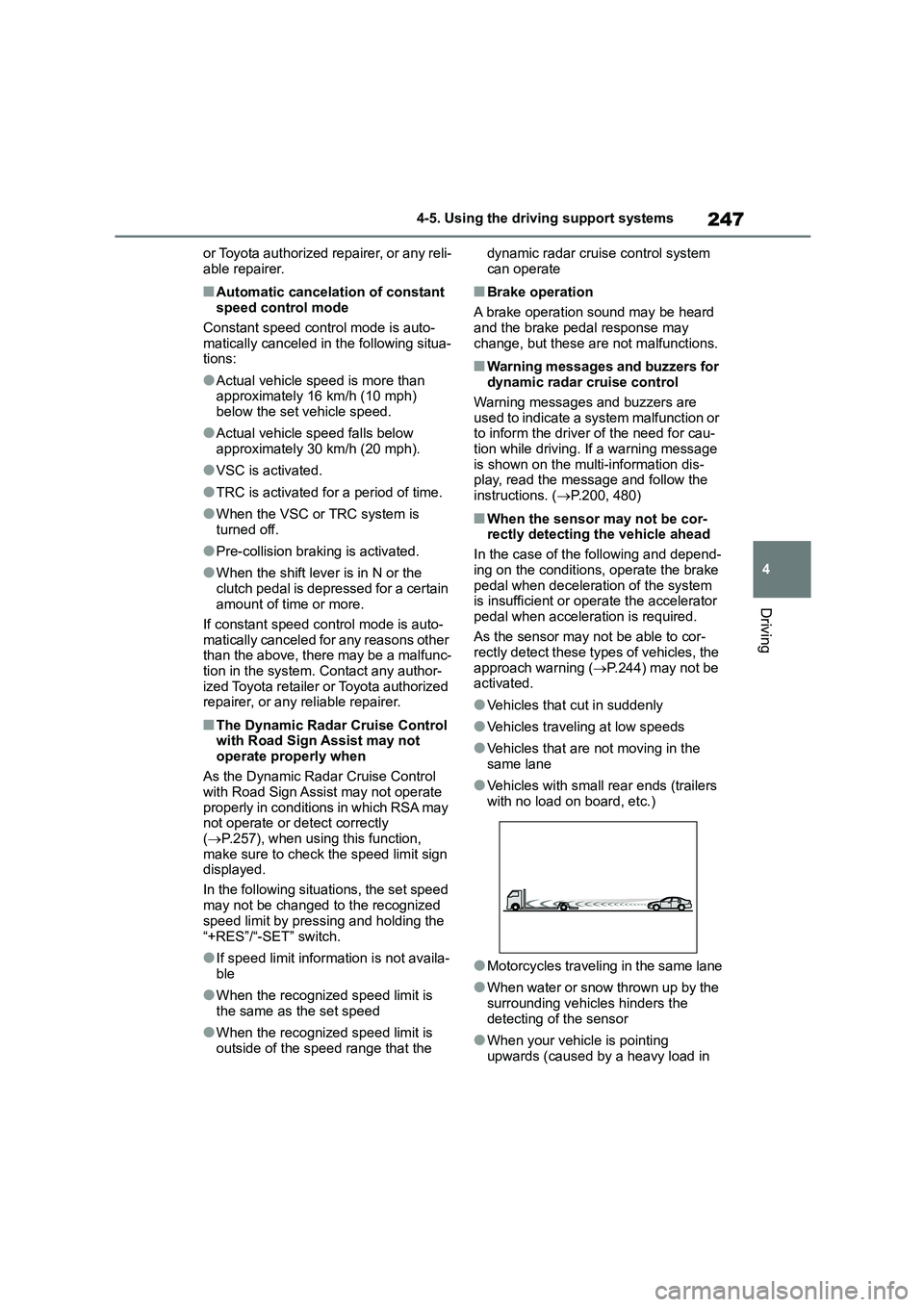
247
4
4-5. Using the driving support systems
Driving
or Toyota authorized repairer, or any reli-
able repairer.
■Automatic cancelation of constant speed control mode
Constant speed control mode is auto-
matically canceled in the following situa- tions:
●Actual vehicle speed is more than approximately 16 km/h (10 mph)
below the set vehicle speed.
●Actual vehicle speed falls below
approximately 30 km/h (20 mph).
●VSC is activated.
●TRC is activated for a period of time.
●When the VSC or TRC system is
turned off.
●Pre-collision braking is activated.
●When the shift lever is in N or the
clutch pedal is depressed for a certain
amount of time or more.
If constant speed control mode is auto-
matically canceled for any reasons other
than the above, there may be a malfunc- tion in the system. Contact any author-
ized Toyota retailer or Toyota authorized
repairer, or any reliable repairer.
■The Dynamic Radar Cruise Control with Road Sign Assist may not
operate properly when
As the Dynamic Radar Cruise Control with Road Sign Assist may not operate
properly in conditions in which RSA may
not operate or detect correctly ( P.257), when using this function,
make sure to check the speed limit sign
displayed.
In the following situations, the set speed
may not be changed to the recognized
speed limit by pressing and holding the
“+RES”/“-SET” switch.
●If speed limit information is not availa-
ble
●When the recognized speed limit is
the same as the set speed
●When the recognized speed limit is
outside of the speed range that the
dynamic radar cruise control system
can operate
■Brake operation
A brake operation sound may be heard
and the brake pedal response may
change, but these are not malfunctions.
■Warning messages and buzzers for dynamic radar cruise control
Warning messages and buzzers are
used to indicate a system malfunction or to inform the driver of the need for cau-
tion while driving. If a warning message
is shown on the multi-information dis- play, read the message and follow the
instructions. ( P.200, 480)
■When the sensor may not be cor-
rectly detecting the vehicle ahead
In the case of the following and depend-
ing on the conditions, operate the brake
pedal when deceleration of the system is insufficient or operate the accelerator
pedal when acceleration is required.
As the sensor may not be able to cor- rectly detect these types of vehicles, the
approach warning ( P.244) may not be
activated.
●Vehicles that cut in suddenly
●Vehicles traveling at low speeds
●Vehicles that are not moving in the same lane
●Vehicles with small rear ends (trailers with no load on board, etc.)
●Motorcycles traveling in the same lane
●When water or snow thrown up by the
surrounding vehicles hinders the
detecting of the sensor
●When your vehicle is pointing
upwards (caused by a heavy load in
Page 260 of 678

2584-5. Using the driving support systems
●The vehicle is driven in a country with
a different direction of traffic.
●The navigation system map data is
outdated.
●The navigation system is not operat-
ing.
●The speed information displayed on
the meter and on the navigation sys- tem may be different due to the navi-
gation system us ing map data.
■Speed limit sign display
If the engine switch was last turned off while a speed limit sign was displayed
on the multi-information display, the
same sign displays again when the engine switch is turned to ON.
■If “RSA Malfunction Visit Your
Dealer” is shown
The system may be malfunctioning. Have the vehicle inspected by any
authorized Toyota retailer or Toyota
authorized repairer, or any reliable repairer.
■Customization
Some functions can be customized.
( P.538)
*: If equipped
BSM (Blind Spot Moni-
tor)*
The Blind Spot Monitor is a
system that uses rear side
radar sensors installed on the
inner side of the rear bumper
on the left and right side to
assist the driver in confirming
safety when changing lanes.
WA R N I N G
■Cautions regarding the use of the system
The driver is solely responsible for
safe driving. Always drive safely, tak- ing care to observe your
surroundings.
The Blind Spot Monitor is a supple- mentary function which alerts the
driver that a vehicle is in a blind spot
of the outside rear view mirrors or is approaching rapidly from behind into
a blind spot. Do not overly rely on the
Blind Spot Monitor. As the function cannot judge if it is safe to change
lanes, over reliance could lead to an
accident resulting in death or serious injury.
As the system may not function cor-
rectly under certain conditions, the driver’s own visual confirmation of
safety is necessary.
Page 261 of 678

259
4
4-5. Using the driving support systems
Driving
Meter control switches
Turning the Blind Spot Monitor on/off.
Outside rear view mirror indica-
tors
When a vehicle is detected in a blind
spot of the outside rear view mirrors or
approaching rapidly from behind into a
blind spot, the outside rear view mirror
indicator on the detected side will illumi-
nate. If the turn signal lever is operated
toward the detected side, the outside
rear view mirror indicator flashes.
BSM indicator
Illuminates when the Blind Spot Monitor
is enabled
■Outside rear view mirror indicator visibility
In strong sunlight, the outside rear view
mirror indicator may be difficult to see.
■When “Blind Spot Monitor Unavail- able” is shown on the multi-infor-
mation display
Ice, snow, mud, etc., may be attached to the rear bumper around the sensors.
( P.259) The system should return to
normal operation after removing the ice,
snow, mud, etc. from the rear bumper. Additionally, the sensors may not oper-
ate normally when driving in extremely
hot or cold environments.
■When “Blind Spot Monitor Malfunc-
tion Visit Your Dealer” is shown on the multi-information display
There may be a sensor malfunction of
misaligned. Have the vehicle inspected by any authorized Toyota retailer or
Toyota authorized repairer, or any relia-
ble repairer.
■Customization
Some functions can be customized.
( P.538)
System components
WA R N I N G
■To ensure the system can oper-
ate properly
Blind Spot Monitor sensors are
installed behind the left and right
sides of the rear bumper respectively. Observe the following to ensure the
Blind Spot Monitor can operate cor-
rectly.
Page 266 of 678
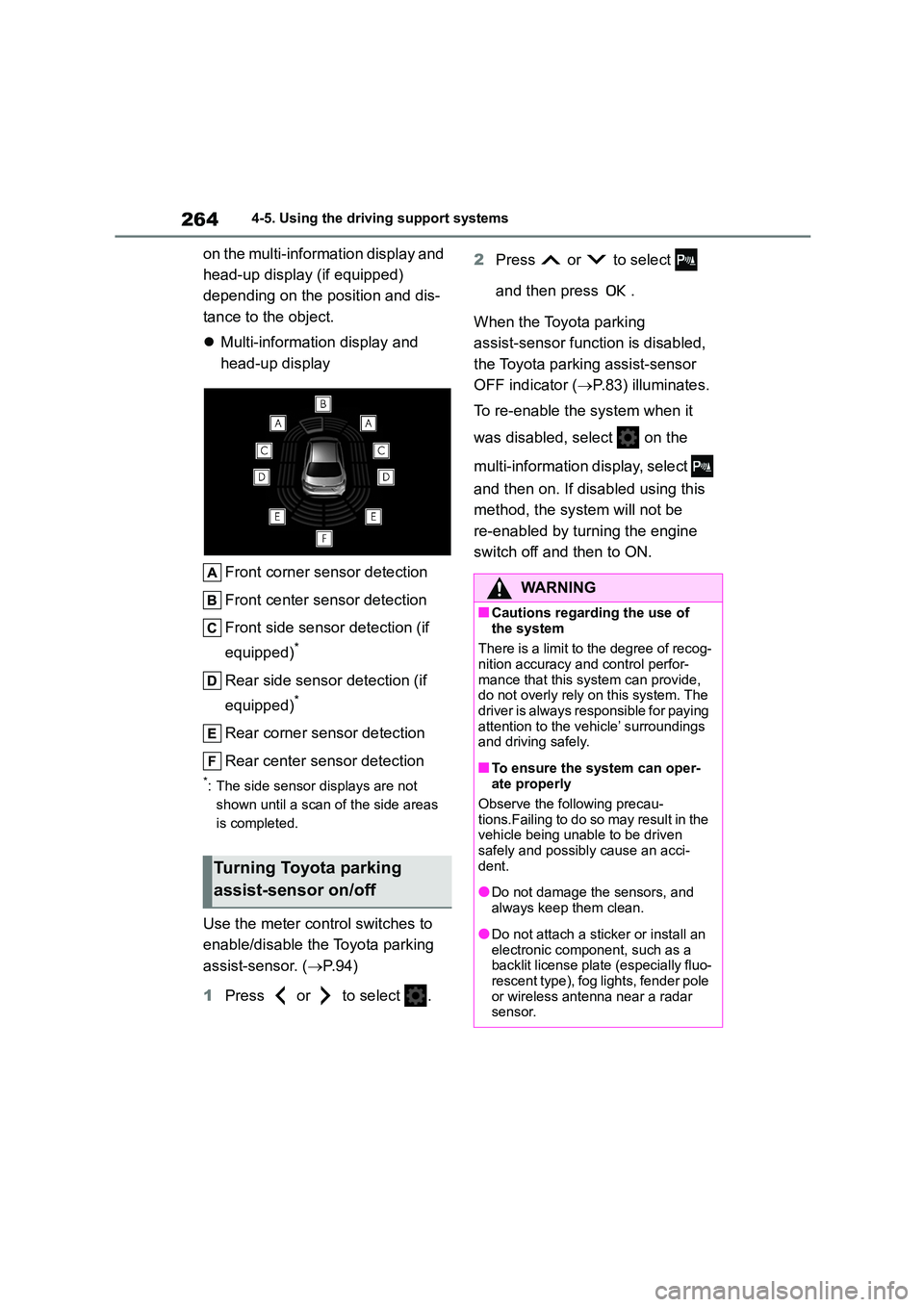
2644-5. Using the driving support systems
on the multi-information display and
head-up display (if equipped)
depending on the position and dis-
tance to the object.
Multi-information display and
head-up display
Front corner sensor detection
Front center sensor detection
Front side sensor detection (if
equipped)*
Rear side sensor detection (if
equipped)*
Rear corner sensor detection
Rear center sensor detection
*: The side sensor displays are not
shown until a scan of the side areas
is completed.
Use the meter control switches to
enable/disable the Toyota parking
assist-sensor. ( P. 9 4 )
1 Press or to select .
2 Press or to select
and then press .
When the Toyota parking
assist-sensor function is disabled,
the Toyota parking assist-sensor
OFF indicator ( P.83) illuminates.
To re-enable the system when it
was disabled, select on the
multi-information di splay, select
and then on. If disabled using this
method, the sy stem will not be
re-enabled by turning the engine
switch off and then to ON.
Turning Toyota parking
assist-sensor on/off
WA R N I N G
■Cautions regarding the use of
the system
There is a limit to the degree of recog- nition accuracy and control perfor-
mance that this system can provide,
do not overly rely on this system. The driver is always responsible for paying
attention to the vehicle’ surroundings
and driving safely.
■To ensure the system can oper-
ate properly
Observe the following precau-
tions.Failing to do so may result in the
vehicle being unable to be driven safely and possibly cause an acci-
dent.
●Do not damage the sensors, and
always keep them clean.
●Do not attach a sti cker or install an
electronic component, such as a
backlit license plate (especially fluo- rescent type), fog lights, fender pole
or wireless antenna near a radar
sensor.
Page 268 of 678
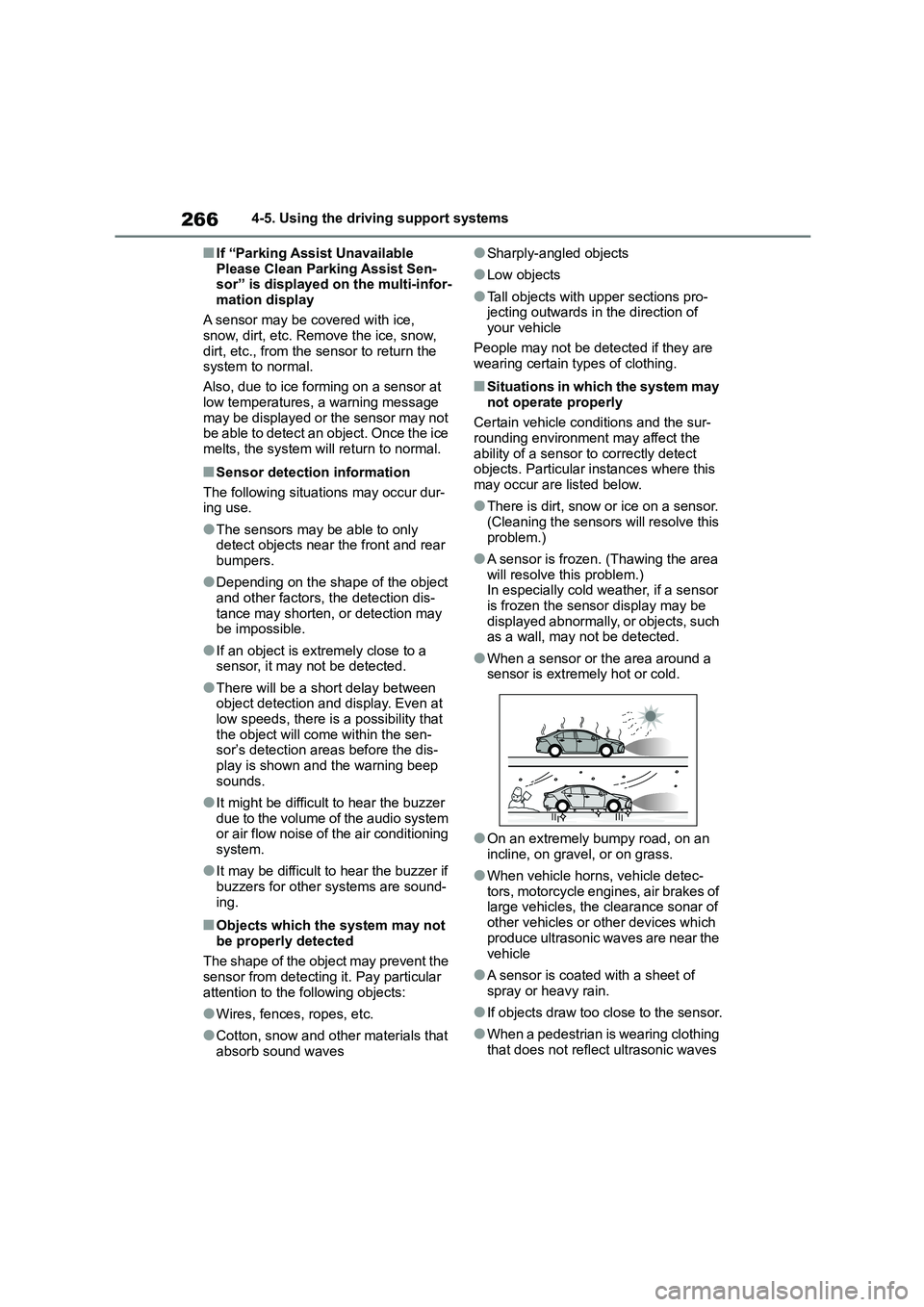
2664-5. Using the driving support systems
■If “Parking Assist Unavailable
Please Clean Parking Assist Sen- sor” is displayed on the multi-infor-
mation display
A sensor may be covered with ice, snow, dirt, etc. Remove the ice, snow,
dirt, etc., from the sensor to return the
system to normal.
Also, due to ice forming on a sensor at
low temperatures, a warning message
may be displayed or the sensor may not be able to detect an object. Once the ice
melts, the system will return to normal.
■Sensor detection information
The following situations may occur dur- ing use.
●The sensors may be able to only detect objects near the front and rear
bumpers.
●Depending on the shape of the object
and other factors, the detection dis-
tance may shorten, or detection may be impossible.
●If an object is extremely close to a sensor, it may not be detected.
●There will be a short delay between object detection and display. Even at
low speeds, there is a possibility that
the object will come within the sen- sor’s detection areas before the dis-
play is shown and the warning beep
sounds.
●It might be difficult to hear the buzzer
due to the volume of the audio system or air flow noise of the air conditioning
system.
●It may be difficult to hear the buzzer if
buzzers for other systems are sound-
ing.
■Objects which the system may not
be properly detected
The shape of the object may prevent the
sensor from detecting it. Pay particular
attention to the following objects:
●Wires, fences, ropes, etc.
●Cotton, snow and other materials that
absorb sound waves
●Sharply-angled objects
●Low objects
●Tall objects with upper sections pro- jecting outwards in the direction of
your vehicle
People may not be detected if they are wearing certain types of clothing.
■Situations in which the system may
not operate properly
Certain vehicle conditions and the sur- rounding environment may affect the
ability of a sensor to correctly detect
objects. Particular instances where this may occur are listed below.
●There is dirt, snow or ice on a sensor. (Cleaning the sensors will resolve this
problem.)
●A sensor is frozen. (Thawing the area
will resolve this problem.)
In especially cold weather, if a sensor is frozen the sensor display may be
displayed abnormally, or objects, such
as a wall, may not be detected.
●When a sensor or the area around a
sensor is extremely hot or cold.
●On an extremely bumpy road, on an
incline, on gravel, or on grass.
●When vehicle horns, vehicle detec-
tors, motorcycle engines, air brakes of large vehicles, the clearance sonar of
other vehicles or other devices which
produce ultrasonic waves are near the
vehicle
●A sensor is coated with a sheet of
spray or heavy rain.
●If objects draw too close to the sensor.
●When a pedestrian is wearing clothing
that does not reflect ultrasonic waves
Page 273 of 678
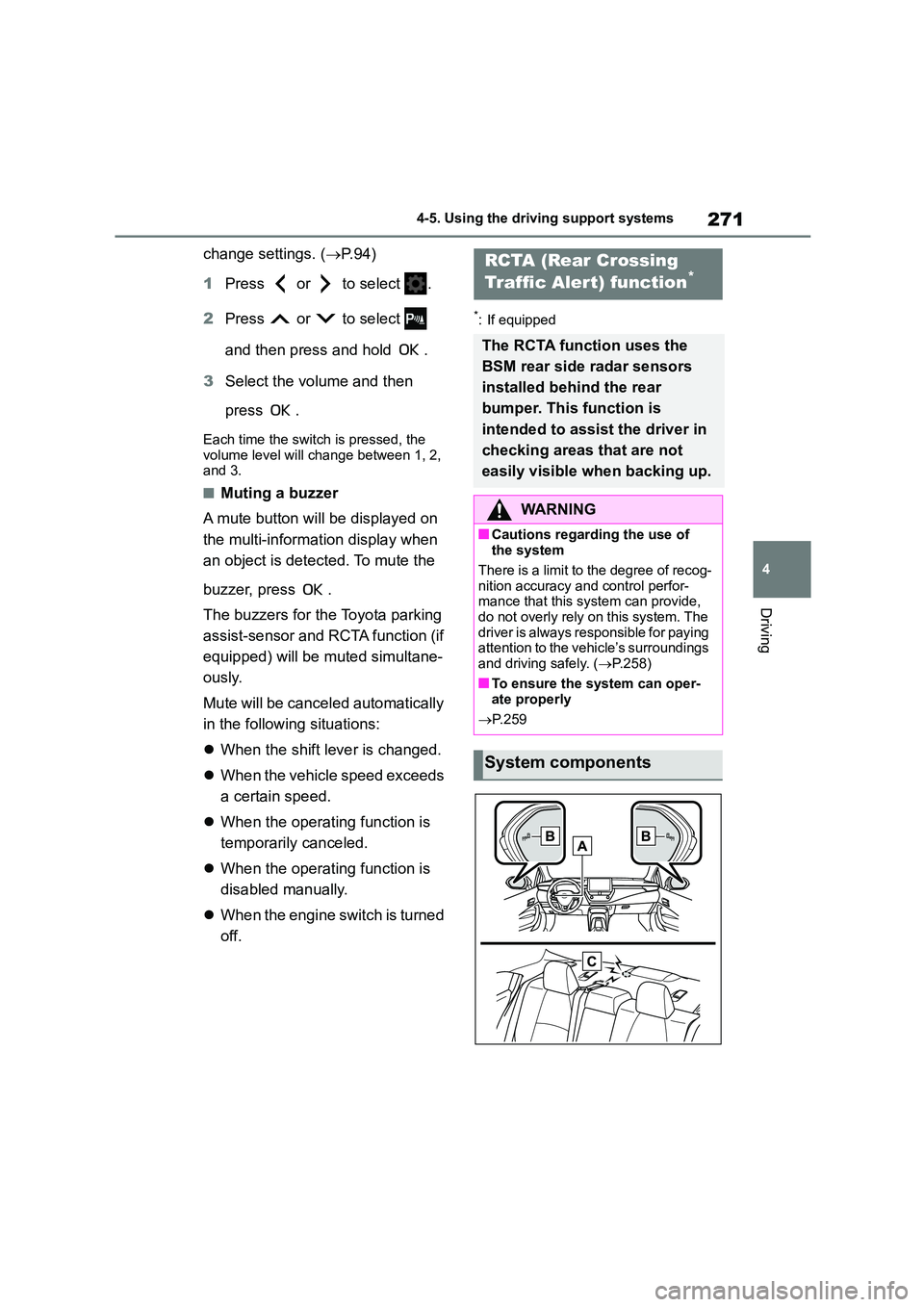
271
4
4-5. Using the driving support systems
Driving
change settings. ( P. 9 4 )
1 Press or to select .
2 Press or to select
and then press and hold .
3 Select the volume and then
press .
Each time the switch is pressed, the
volume level will change between 1, 2, and 3.
■Muting a buzzer
A mute button will be displayed on
the multi-information display when
an object is detected. To mute the
buzzer, press .
The buzzers for the Toyota parking
assist-sensor and RCTA function (if
equipped) will be muted simultane-
ously.
Mute will be cancel ed automatically
in the following situations:
When the shift lever is changed.
When the vehicle speed exceeds
a certain speed.
When the operating function is
temporarily canceled.
When the operating function is
disabled manually.
When the engine switch is turned
off.
*: If equipped
RCTA (Rear Crossing
Traffic Alert) function*
The RCTA function uses the
BSM rear side radar sensors
installed behind the rear
bumper. This function is
intended to assist the driver in
checking areas that are not
easily visible when backing up.
WA R N I N G
■Cautions regarding the use of the system
There is a limit to the degree of recog-
nition accuracy and control perfor- mance that this system can provide,
do not overly rely on this system. The
driver is always responsible for paying attention to the vehicle’s surroundings
and driving safely. ( P.258)
■To ensure the system can oper- ate properly
P. 2 5 9
System components
Page 279 of 678
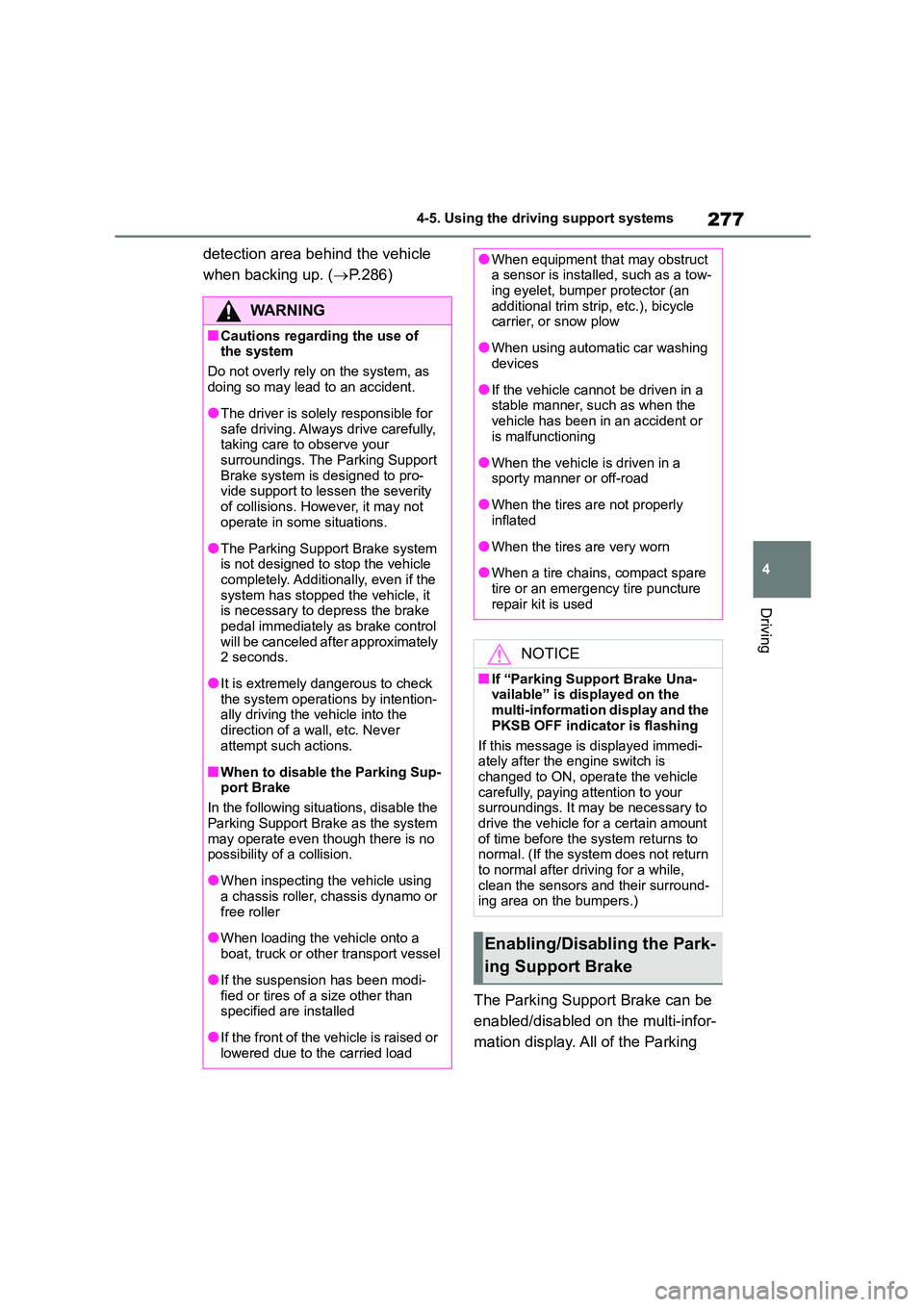
277
4
4-5. Using the driving support systems
Driving
detection area behind the vehicle
when backing up. ( P.286)
The Parking Support Brake can be
enabled/disabled on the multi-infor-
mation display. All of the Parking
WA R N I N G
■Cautions regarding the use of
the system
Do not overly rely on the system, as
doing so may lead to an accident.
●The driver is solely responsible for safe driving. Always drive carefully,
taking care to observe your
surroundings. The Parking Support Brake system is designed to pro-
vide support to lessen the severity
of collisions. However, it may not operate in some situations.
●The Parking Support Brake system is not designed to stop the vehicle
completely. Additionally, even if the
system has stopped the vehicle, it is necessary to depress the brake
pedal immediately as brake control
will be canceled after approximately 2 seconds.
●It is extremely dangerous to check the system operatio ns by intention-
ally driving the vehicle into the
direction of a wall, etc. Never attempt such actions.
■When to disable the Parking Sup-port Brake
In the following situations, disable the
Parking Support Br ake as the system may operate even though there is no
possibility of a collision.
●When inspecting the vehicle using
a chassis roller, chassis dynamo or
free roller
●When loading the vehicle onto a
boat, truck or other transport vessel
●If the suspension has been modi-
fied or tires of a size other than specified are installed
●If the front of the vehicle is raised or lowered due to the carried load
●When equipment that may obstruct a sensor is installed, such as a tow-
ing eyelet, bumper protector (an
additional trim strip, etc.), bicycle carrier, or snow plow
●When using automatic car washing devices
●If the vehicle cannot be driven in a stable manner, such as when the
vehicle has been in an accident or
is malfunctioning
●When the vehicle is driven in a
sporty manner or off-road
●When the tires are not properly
inflated
●When the tires are very worn
●When a tire chains, compact spare
tire or an emergency tire puncture
repair kit is used
NOTICE
■If “Parking Support Brake Una- vailable” is displayed on the
multi-information display and the
PKSB OFF indicator is flashing
If this message is displayed immedi-
ately after the engine switch is
changed to ON, operate the vehicle carefully, paying attention to your
surroundings. It may be necessary to
drive the vehicle for a certain amount of time before the system returns to
normal. (If the system does not return
to normal after driving for a while, clean the sensors and their surround-
ing area on the bumpers.)
Enabling/Disabling the Park-
ing Support Brake
Page 316 of 678

3144-5. Using the driving support systems
*: If equipped
Each time the switch is pressed, the
system changes betw een sport mode
and normal mode.
1 Normal mode
Provides an optimal balance of fuel
economy, quietness, and dynamic per-
formance. Suitable for normal driving.
2 Sport mode
Controls the transmission and engine to
provide quick, powerful acceleration.
This mode also changes the steering
feel, making it suitable for when agile
driving response is desired, such as
when driving on roads with many
curves.
When sport mode is selected, sport
mode indicator comes on.
■Automatic deactivation of sport
mode
If the engine switch is turned off after
driving in sport mode, the drive mode
will be changed to normal mode.Driving mode select
switch*
The driving modes can be
selected to suit driving condi-
tion.
Selecting a drive mode
Page 318 of 678

3164-5. Using the driving support systems
■ABS (Anti-lock Brake System)
Helps to prevent wheel lock when
the brakes are applied suddenly, or
if the brakes are applied while driv-
ing on a slippery road surface
■Brake assist
Generates an increased level of
braking force after the brake pedal
is depressed when the system
detects a panic stop situation
■VSC (Vehicle St ability Control)
Helps the driver to control skidding
when swerving suddenly or turning
on slippery road surfaces.
■VSC+ (Vehicle Stability Con-
trol+)
Provides cooperative control of the
ABS, TRC, VSC and EPS.
Helps to maintain directional stabil-
ity when swerving on slippery road
surfaces by controlling steering per-
formance.
■TRC (Traction Control)
Helps to maintain drive power and
prevent the drive wheels from spin-
ning when starting the vehicle or
accelerating on slippery roads
■Active Cornering Assist (ACA)
Helps to prevent the vehicle from
drifting to the outer side by perform-
ing inner wheel brake control when
attempting to acce lerate while turn-
ing
■Hill-start assist control
Helps to reduce the backward
movement of the vehicle when
starting on an uphill
■EPS (Electric Po wer Steering)
Employs an electric motor to
reduce the amount of effort needed
to turn the steering wheel.
■Emergency brake signal
When the brakes are applied sud-
denly, the emergency flashers auto-
matically flash to alert the vehicle
behind.
■Secondary Collision Brake (if
equipped)
When the SRS airbag sensor
detects a collisi on and the system
operates, the brakes and brake
lights are automatically controlled
to reduce the vehicle speed and
help reduce the poss ibility of further
damage due to a secondary colli-
sion.
Driving assist systems
To keep driving safety and per-
formance, the following sys-
tems operate au tomatically in
response to various driving sit-
uations. Be aware, however,
that these systems are supple-
mentary and should not be
relied upon too heavily when
operating the vehicle.
Summary of the driving
assist systems
Page 321 of 678
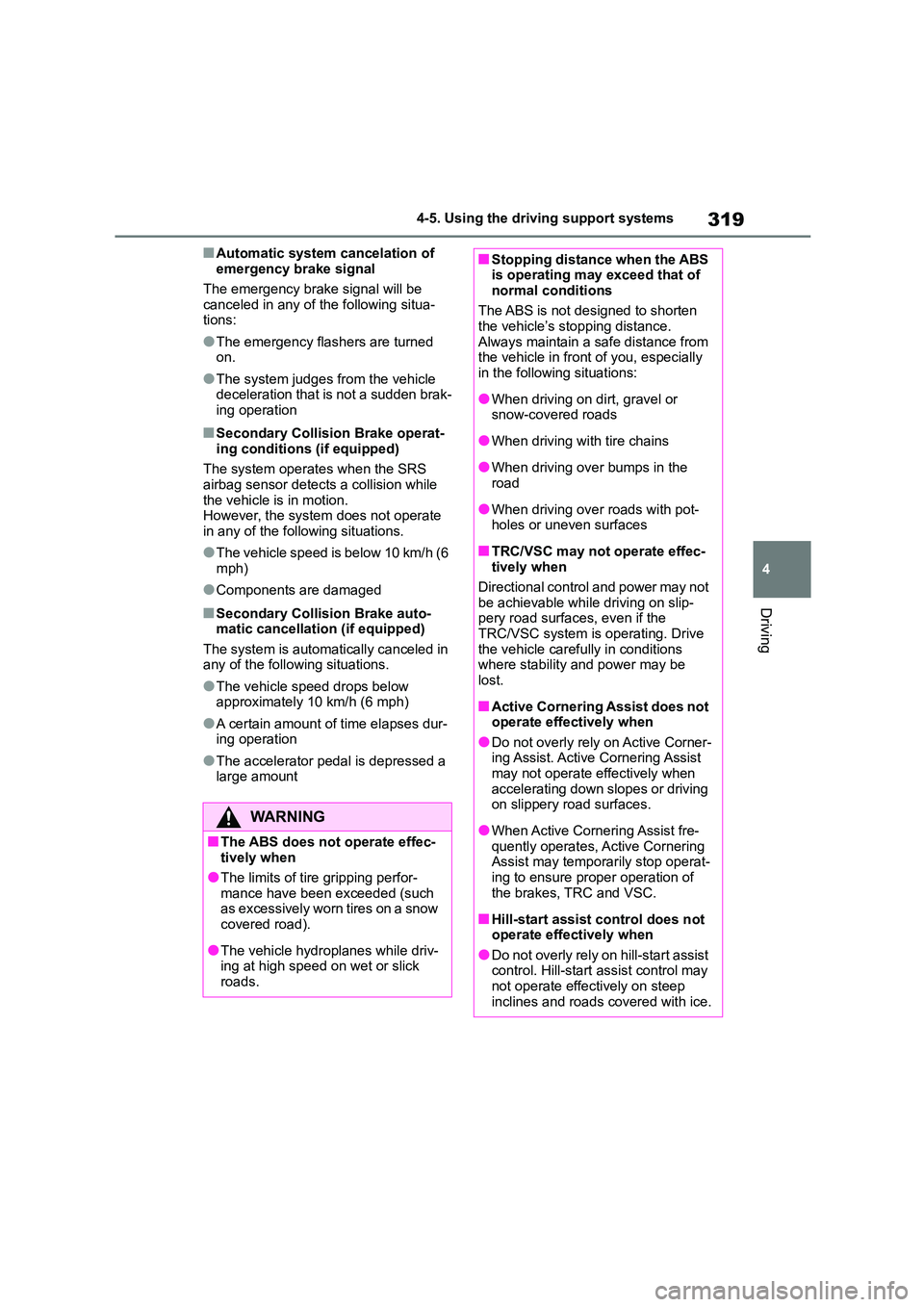
319
4
4-5. Using the driving support systems
Driving
■Automatic system cancelation of
emergency brake signal
The emergency brake signal will be
canceled in any of the following situa-
tions:
●The emergency flashers are turned
on.
●The system judges from the vehicle
deceleration that is not a sudden brak- ing operation
■Secondary Collision Brake operat-
ing conditions (if equipped)
The system operates when the SRS airbag sensor detects a collision while
the vehicle is in motion.
However, the system does not operate in any of the following situations.
●The vehicle speed is below 10 km/h (6 mph)
●Components are damaged
■Secondary Collision Brake auto-matic cancellation (if equipped)
The system is automati cally canceled in
any of the following situations.
●The vehicle speed drops below
approximately 10 km/h (6 mph)
●A certain amount of time elapses dur-
ing operation
●The accelerator pedal is depressed a
large amount
WA R N I N G
■The ABS does not operate effec- tively when
●The limits of tire gripping perfor-
mance have been exceeded (such as excessively worn tires on a snow
covered road).
●The vehicle hydroplanes while driv-
ing at high speed on wet or slick
roads.
■Stopping distance when the ABS is operating may exceed that of
normal conditions
The ABS is not designed to shorten the vehicle’s stopping distance.
Always maintain a safe distance from
the vehicle in front of you, especially in the following situations:
●When driving on dirt, gravel or snow-covered roads
●When driving with tire chains
●When driving over bumps in the
road
●When driving over roads with pot-
holes or uneven surfaces
■TRC/VSC may not operate effec-
tively when
Directional control and power may not
be achievable while driving on slip-
pery road surfaces, even if the TRC/VSC system is operating. Drive
the vehicle carefu lly in conditions
where stability and power may be lost.
■Active Cornering Assist does not operate effectively when
●Do not overly rely on Active Corner-
ing Assist. Active Cornering Assist may not operate effectively when
accelerating down slopes or driving
on slippery road surfaces.
●When Active Cornering Assist fre-
quently operates, Active Cornering Assist may temporarily stop operat-
ing to ensure proper operation of
the brakes, TRC and VSC.
■Hill-start assist control does not
operate effectively when
●Do not overly rely on hill-start assist control. Hill-start assist control may
not operate effectively on steep
inclines and roads covered with ice.